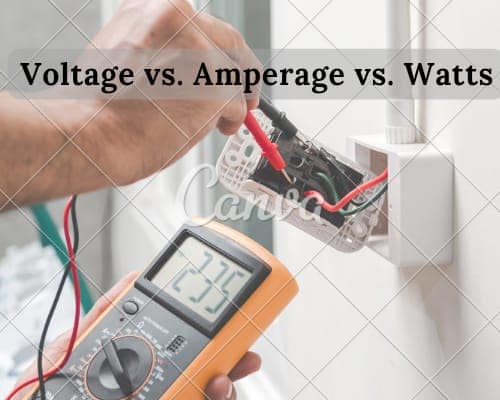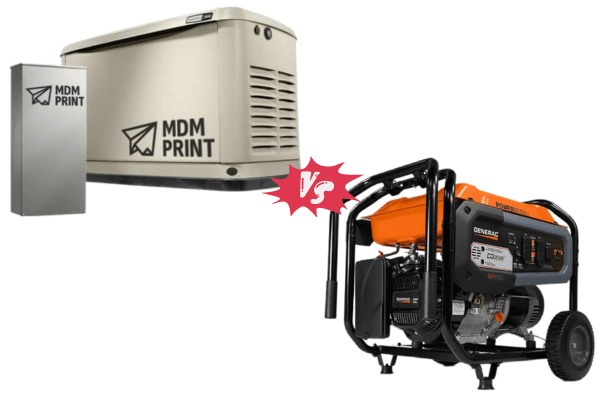
I’m guessing you’ve been doing some work around the house lately and started wondering about all those electrical terms you keep seeing, like voltage, amps, and watts, right? I know it can be confusing trying to sort out what each one actually means.
So in this guide, I’ll explain the differences between Volts vs. Amps vs. Watts and also, explain what is really means for each of them.
So, if you’re using electronic appliances or working on a project, then you must read it carefully because it’ll save you from any danger.
Volts vs. Amps vs. Watts
Voltage vs. Amperage
Have you ever wondered what the difference is between voltage and amperage? I know I used to get those two confused all the time when I was learning about electricity. The terms get thrown around so much when talking about things like batteries, circuits, and household appliances. But they don’t actually mean the same thing.
Think of voltage like the pressure behind the flow of electrons in a circuit. It’s what gives those tiny charged particles a “push” to start moving from the battery or power source. Higher voltage means there is more pressure applied. Amperage, on the other hand, refers to the number of electrons that are actually flowing – it’s a measure of the “volume” of electrical current.
To use a water analogy, the voltage would be like the water pressure coming from your faucet. A higher-pressure shower will feel stronger even if the water volume (amperage) is the same. But if you want to water multiple plants at once, you’ll need more water volume (amperage) flowing through the hose regardless of the pressure setting.
The key thing to remember is that both voltage and amperage work together. You need adequate voltage to push enough amperage through a circuit. Too little voltage and there won’t be enough pressure to move a sufficient number of electrons no matter how many are available. But pumping too much voltage can damage components not rated to handle higher power levels.
What is Voltage?
Do you know what exactly voltage means when we talk about things like batteries and household electricity? I used to be confused about it too. It seems like such a simple term, but voltage can actually describe some pretty complex stuff that’s happening behind the scenes with electricity. Let me try to elaborate on it in everyday language.
Think of voltage kind of like water pressure. It represents the “push” or force that’s driving the electrons to flow through a circuit. Higher voltage means there’s more pressure and speed behind the movement of those tiny charged particles. We measure this in volts. So a 9-volt battery has more pressure than a 1.5-volt battery, for example.
But voltage on its own doesn’t tell you how much actual current, or electrons, are moving. That’s where amps come in. You could have a high voltage but very little current if there’s a restriction in the circuit. It’s like water pressure in a hose – it could be cranked way up but the hose diameter is tiny, so not much water volume flows.
It’s also important to note that the danger from electricity isn’t just about voltage – it’s the combination of voltage and current, or amps. A 9-volt battery alone usually isn’t enough to cause harm. But hook that same battery up to a low-resistance circuit and it could generate a current, or amps, high enough to give a nasty shock.
Read about impact of voltage fluctuation.
What is Amperage?
When it comes to electricity, we often hear about things like amps, wattage, and voltage. But what do they really mean? Let me try to explain amps, or amperage, in a simple way.
Think of amps as representing the amount of electricity actually flowing through a circuit at any given time. It’s a measure of the “volume” of electrons moving past a certain point. We use the term amps or amperage (abbreviated as A).
A higher amp rating means more electrons are flowing. For example, a 60-watt light bulb might draw 0.5 amps, while a hair dryer could need 10 or more amps to operate. So amps tell you how much current, or electricity, is traveling through the wires.
It’s important to make sure the amperage a device needs doesn’t exceed the rating of the circuit. Think of it like water pressure and volume in a hose. You could have high pressure from a strong water source, but if the hose is tiny, not much water will actually flow. Likewise, you need an adequately sized circuit to handle the amperage drawn by an appliance.
The next time you see an amp rating, think of it as telling you how much electricity is flowing through that part of the system. Understanding amps can help troubleshoot if a fuse keeps blowing or an outlet feels warm.
What are the Effects of Amperages on Electrical Shock?
Have you ever wondered just how dangerous electricity can be? We use it in our homes every day without much thought, but did you know even a small shock can have serious effects on your body?
The amount of current, or amperage, flowing through you determines the severity of injury from an electrical accident. Our friends at OSHA break it down helpfully based on scientific research. Even levels as low as 5 milliamps (mA), which is 1/1000th of an amp, can cause an unpleasant jolt. But things escalate quickly from there.
Between 6-30mA, shocks transition to actual pain and loss of muscle control. Your body may react without your consent. From 50-150mA, the classification moves to “extreme pain” and potentially life-threatening issues like stopped breathing. Above 1000mA, the current can disrupt your heart rhythm fatally.
It’s sobering to consider that a typical home circuit provides 15,000-20,000mA daily! Proper safety precautions are a must. Turn off power before working with wires, keep children away from outlets, and never use electrical devices in wet areas like the shower.
Watts – What Do They Really Mean?
Have you ever wondered what all those numbers on your appliances actually represent? Things like 1200 watts, 500 watts – it’s easy to get confused about what they’re really telling us.
In simple terms, we can all understand what’s actually happening with our electricity usage. Watts are a measurement of power, specifically how much work is getting done by the current flowing through a circuit.
Think of it like a waterwheel at a mill. The water pressure (voltage) pushes the water (amps) through the wheel, making it spin and grind the grain (work). More pressure and flow means more grinding power. That’s basically what watts quantify for electricity.
It comes from multiplying the voltage by the amps – so if you’ve got 120 volts pushing 5 amps, you end up with 600 watts. Higher voltage or amperage equals more watts churning out power.
So when you look at the wattage rating on your appliances, it’s telling you how much “grinding” or work that device will do. A 1200 watt hair dryer has more power than a 500 watt microwave. And your whole home circuit might be rated for 15,000 watts before the fuse blows!
The nice thing is, watts give us a universal language to compare energy usage. So next time you’re shopping, don’t be afraid to consider the wattages – it’ll help you better understand your electricity costs and pick products with the right amount of grind for your needs.
Watts vs Amps – Making Sense of Electricity
Ever wonder about all those numbers you see when you plug something in? Volts, amps, watts – it can be downright confusing trying to understand electricity. But don’t stress, I’m here to break it down in simple terms.
You’re right that both watts and amps relate to voltage and current. But they actually measure two different things. Amps (short for amperes) tell you how much current is flowing through the circuit. It’s like the amount of water pumping through the pipes.
But on its own, current doesn’t tell the full story. You also need to know the voltage, or water pressure. That’s where watts come in – they show how much work is getting done by multiplying the voltage by the amps.
Let me give you an example. Say you’ve got a hairdryer plugged into a 120-volt outlet. It draws 10 amps. Using the formula of Volts x Amps = Watts, that works out to 1200 watts. So while the current is 10 amps, the true power used is 1200 watts.
Amps only tell half the picture. Watts account for both current and voltage to reveal the actual energy being consumed. It’s like the difference between gallons of water flowing and horsepower generated by that water.
What are Ohms?
Have you ever noticed how electricity seems to get weaker the longer the cord is, or how some devices draw more power than others? There’s actually a good explanation for that involving a concept called resistance.
Resistance, measured in ohms, refers to anything that slows down or reduces the flow of electrical current in a circuit. Every material – from wires to appliances – puts up some level of resistance. Think of it like friction for electricity.
The wider and shorter a wire, the lower its resistance and the easier current can cruise through. But use a narrow or lengthy cord, and there’s more obstacles in the way, like a kinked garden hose. Current has to push harder to overcome it.
That’s why longer extension cords often mean dimmer lights – the extra resistance saps some of the power. And a space heater with a lower wattage than your hair dryer? It encounters more resistance to current internally due to its construction.
Ohms allow us to quantify resistance so we can determine how components will impact a circuit. More resistance equals less current at the same voltage. It all balances out thanks to some simple math.
The takeaway? Resistance is a natural part of electricity, and understanding its effects can help explain everyday phenomena and get the best performance from our devices.
Understanding Watts and Ohms
Electricity can definitely seem like wizardry if you don’t understand some of the basic concepts behind it. But don’t worry – once you get watts and ohms, the whole system starts to make a lot more sense.
Let’s start with watts. You’re right that wattage ratings tell you more than just brightness – they indicate how much power something needs to operate. Think of it like fuel for electricity. A 60-watt bulb needs a steady 60-watt supply to burn bright.
And because watts are voltage times current, you can use the wattage number to figure out how many amps of electricity something will draw. Really handy for checking you don’t overload a circuit!
Which brings us to ohms. As we talked about before, ohms measure resistance in a circuit. Resistance is what slows electricity down, so more ohms means less current flow at the same voltage.
Understanding these two concepts together is key. The resistance of a device determines how many amps it needs to operate at a certain wattage. Less resistance, and the same wattage appliance would draw fewer amps of power.




